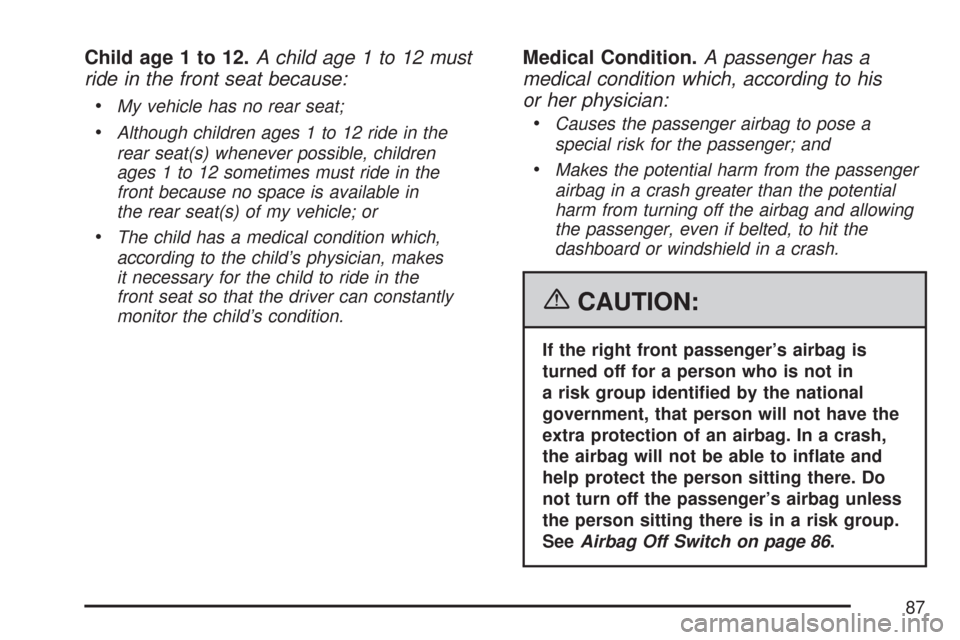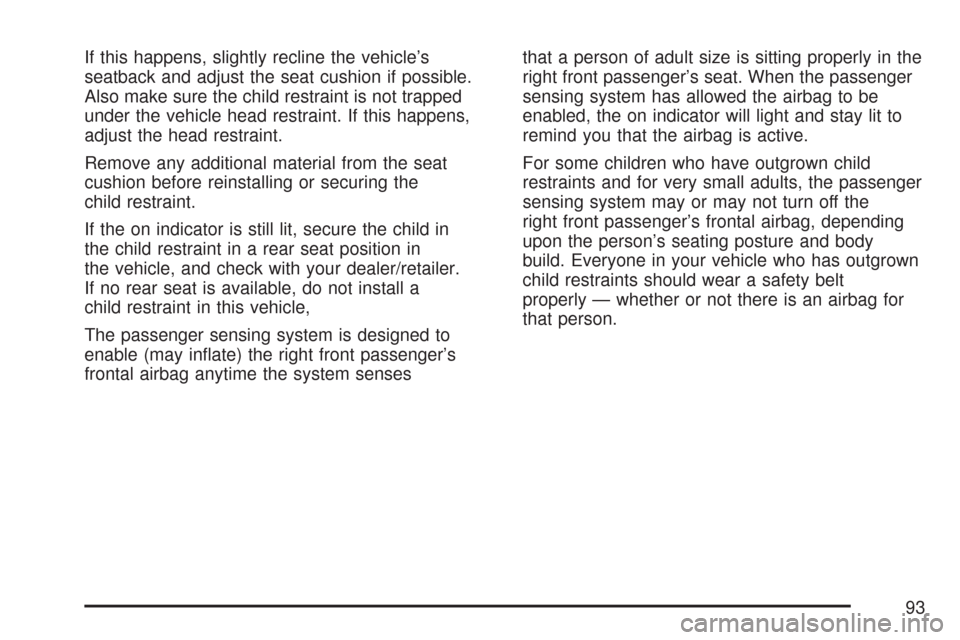Page 86 of 458
Airbag Off Switch
If your vehicle has one of the switches pictured
in the following illustrations, your vehicle has
an airbag off switch that you can use to turn off
the right front passenger’s airbag.
If your vehicle does not have an airbag off
switch, it may have a passenger sensing system.
SeePassenger Sensing System on page 89.This switch should only be turned to airbag OFF if
the person in the right front passenger’s position
is a member of a passenger risk group identified
by the national government as follows:
Infant.An infant (less than 1 year old) must
ride in the front seat because:
•
My vehicle has no rear seat;
•My vehicle has a rear seat too small to
accommodate a rear-facing infant seat; or
•The infant has a medical condition which,
according to the infant’s physician, makes
it necessary for the infant to ride in the
front seat so that the driver can constantly
monitor the child’s condition.
United StatesCanada
86
Page 87 of 458

Child age 1 to 12.A child age 1 to 12 must
ride in the front seat because:
•
My vehicle has no rear seat;
•Although children ages 1 to 12 ride in the
rear seat(s) whenever possible, children
ages 1 to 12 sometimes must ride in the
front because no space is available in
the rear seat(s) of my vehicle; or
•The child has a medical condition which,
according to the child’s physician, makes
it necessary for the child to ride in the
front seat so that the driver can constantly
monitor the child’s condition.
Medical Condition.A passenger has a
medical condition which, according to his
or her physician:
•
Causes the passenger airbag to pose a
special risk for the passenger; and
•Makes the potential harm from the passenger
airbag in a crash greater than the potential
harm from turning off the airbag and allowing
the passenger, even if belted, to hit the
dashboard or windshield in a crash.
{CAUTION:
If the right front passenger’s airbag is
turned off for a person who is not in
a risk group identi�ed by the national
government, that person will not have the
extra protection of an airbag. In a crash,
the airbag will not be able to in�ate and
help protect the person sitting there. Do
not turn off the passenger’s airbag unless
the person sitting there is in a risk group.
SeeAirbag Off Switch on page 86.
87
Page 88 of 458
To turn off the right front passenger’s airbag,
insert your ignition key into the switch, push in,
and move the switch to the off position.
The airbag off light will come on to let you know
that the right front passenger’s airbag is off.
The light will stay on to remind you that the
airbag is off. The right front passenger’s airbag
will remain off until you turn it back on.
{CAUTION:
If the airbag readiness light ever comes
on when you have turned off the airbag,
it means that something may be wrong
with the airbag system. The right front
passenger’s airbag could in�ate even
though the switch is off. If this ever
happens, do not let anyone whom the
national government has identi�ed as a
member of a passenger airbag risk group
sit in the right front passenger’s position
(for example, do not secure a rear-facing
child restraint in your vehicle) until
you have your vehicle serviced. See
Airbag Readiness Light on page 169
for additional information.
United StatesCanada
88
Page 89 of 458
To turn the right front passenger’s airbag on,
insert your ignition key into the switch, push in,
and move the switch to the on position.
Passenger Sensing System
If your instrument panel has one of the indicators
pictured in the following illustrations, your vehicle
has a passenger sensing system. The passenger
airbag status indicator will be visible when you
start your vehicle in the instrument panel.
If your vehicle does not have a passenger
sensing system, it may have an airbag off switch.
SeeAirbag Off Switch on page 86.
United StatesCanada
United StatesCanada
89
Page 90 of 458

The words ON and OFF, or the symbol for on and
off, will be visible on the instrument panel during
the system check. When the system check is
complete, either the word ON or the word OFF,
or the symbol for on or the symbol for off, will
be visible. SeePassenger Airbag Status Indicator
on page 172.
The passenger sensing system will turn off
the right front passenger’s frontal airbag under
certain conditions. The driver’s airbags are not
part of the passenger sensing system.
The passenger sensing system works with
sensors that are part of the right front passenger’s
seat. The sensors are designed to detect the
presence of a properly seated occupant and
determine if the passenger’s frontal airbag
should be enabled (may inflate) or not.Accident statistics show that children are safer if
they are restrained in the rear rather than the front
seat. We recommend that children be secured
in a rear seat, including: an infant or a child riding
in a rear-facing child restraint; a child riding in
a forward-facing child seat; an older child riding
in a booster seat; and children, who are large
enough, using safety belts.
A label on your sun visor that says, “Never put
a rear-facing child seat in the front.” This is
because the risk to the rear-facing child is so
great, if the airbag deploys.
90
Page 91 of 458

{CAUTION:
A child in a rear-facing child restraint
can be seriously injured or killed if the
right front passenger’s airbag in�ates.
This is because the back of the
rear-facing child restraint would be
very close to the in�ating airbag.
Even though the passenger sensing
system is designed to turn off the right
front passenger’s frontal airbag if the
system detects a rear-facing child
restraint, no system is fail-safe, and
no one can guarantee that an airbag
will not deploy under some unusual
circumstance, even though it is turned off.
CAUTION: (Continued)
CAUTION: (Continued)
We recommend that rear-facing child
restraints be secured in the rear seat,
even if the airbag is off.
If you need to secure a forward-facing
child restraint in the right front seat,
always move the front passenger seat as
far back as it will go. It is better to secure
the child restraint in a rear seat.
If your vehicle does not have a rear seat that
will accommodate a rear-facing child restraint,
we recommend that rear-facing child restraints
not be transported in your vehicle, even if
the airbag is off.
91
Page 92 of 458

The passenger sensing system is designed to turn
off the right front passenger’s frontal airbag if:
•The right front passenger seat is unoccupied.
•The system determines that an infant is
present in a rear-facing infant seat.
•The system determines that a small child is
present in a child restraint.
•The system determines that a small child is
present in a booster seat.
•A right front passenger takes his/her weight
off of the seat for a period of time.
•The right front passenger seat is occupied by
a smaller person, such as a child who has
outgrown child restraints.
•Or, if there is a critical problem with the airbag
system or the passenger sensing system.When the right front passenger’s frontal airbag
has been turned off by the passenger sensing
system, the off indicator will light and stay
lit to remind you that the airbag is off. See
Passenger Airbag Status Indicator on page 172.
If a child restraint has been installed and the
on indicator is lit, turn the vehicle off. Remove
the child restraint from the vehicle and reinstall
the child restraint following the child restraint
manufacturer’s directions and refer toSecuring a
Child Restraint in the Right Front Seat Position
(With Passenger Sensing System)in the Index.
If, after reinstalling the child restraint and restarting
the vehicle, the on indicator is still lit, check to
make sure that the vehicle’s seatback is not
pressing the child restraint into the seat cushion.
92
Page 93 of 458

If this happens, slightly recline the vehicle’s
seatback and adjust the seat cushion if possible.
Also make sure the child restraint is not trapped
under the vehicle head restraint. If this happens,
adjust the head restraint.
Remove any additional material from the seat
cushion before reinstalling or securing the
child restraint.
If the on indicator is still lit, secure the child in
the child restraint in a rear seat position in
the vehicle, and check with your dealer/retailer.
If no rear seat is available, do not install a
child restraint in this vehicle,
The passenger sensing system is designed to
enable (may inflate) the right front passenger’s
frontal airbag anytime the system sensesthat a person of adult size is sitting properly in the
right front passenger’s seat. When the passenger
sensing system has allowed the airbag to be
enabled, the on indicator will light and stay lit to
remind you that the airbag is active.
For some children who have outgrown child
restraints and for very small adults, the passenger
sensing system may or may not turn off the
right front passenger’s frontal airbag, depending
upon the person’s seating posture and body
build. Everyone in your vehicle who has outgrown
child restraints should wear a safety belt
properly — whether or not there is an airbag for
that person.
93